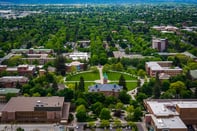Published on
Adapting to Non-Traditional Students Creates Impetus to Innovate Traditional Models

Across the United States, colleges and universities are dealing with challenging marketing conditions. As budgets tighten and the number of high school graduates declines, postsecondary institutions are having to seek out new models of institutional management and new student demographics to remain viable. In this interview, Melissa Vito, Kasey Urquidez and Vincent J. Del Casino Jr. reflect on some of the new audiences they’re adapting to serve and outline how the institution is evolving to ensure these demographics find success.
The EvoLLLution (Evo): Why is it important for colleges and universities that have historically focused on serving the 18- to 22-year-old traditional student population to begin expanding their scope?
Melissa Vito, Kasey Urquidez and Vincent J. Del Casino Jr. (MV/KU/VDC): There are a couple of factors that come into play here. The first is that the traditional pipeline of eligible students is flattening or decreasing across states and markets. The second is an increasing number of non-traditional students seeking postsecondary education. While the traditional 18- to 22-year-old student will always be at the core of our educational offerings, especially on-campus offerings, our focus has broadened to adapt to the needs of non-traditional students who may be returning to college and who want a University of Arizona degree, perhaps in an online, statewide distance setting, or even internationally.
As these student populations evolve, we see an opportunity to diversify our suite of educational offerings and create degree programs that are agnostic in their delivery methods while always delivering on the UA’s rigorous academic standards. In the end, it means more choices for more students. It’s a very exciting time.
Evo: What are some of the most significant differences between attracting prospective high school graduates and attracting non-traditional, adult learners?
MV/KU/VDC: When attracting non-traditional students, we need to be more aware of the factors that influence their decision-making. The reputation of academic programs, their schedule and availability of classes, cost, and career impact are all factors these students are considering. This differs from our more more traditional students, who consider the reputation of academic programs but are less focused on the schedule and cost impact of courses. Additionally, non-traditional students typically have factors to consider that traditional students may not—such as mobility, family obligations, and current career.
On the international level, we’re also making significant inroads and investments in exciting projects like our global micro-campus network, which really changes the game in terms of a worldwide approach to education and the technology to support it. We’re now able to bring UA degrees at local market rates to students in high-demand international locations where the cost and distance of American higher education is prohibitive for most of the population.
In each of these examples, however, we seek to provide a consistency of excellence that cuts across of platforms and settings. So, if an 18-year-old wants a traditional on-campus experience, or to experience the UA from a micro-campus in China, or a 35-year-old wants to advance in her career by finishing a bachelors’ degree online, each student can expect a consistently excellent, world-class education.
Evo: How are you and your team at UA adapting to create (and communicate) an enticing environment to prospective non-traditional learners?
MV/KU/VDC: We have shifted our focus to look at the specific needs of this population and how we can meet these students where they are. For instance, we work with students with specific scheduling requirements and recommend class modalities that best fit their needs and structure programming to best accommodate their ability to attend and include opportunities to bring families. It’s really all about providing the flexibility and convenience that they expect to find with brands like Amazon or Apple.
We’ve built our online model to provide on-campus support to students no matter their distance. Our entire team is housed on campus—and, critically, it has not been outsourced as is the case with nearly all online universities. This approach has resulted in a 93 percent satisfaction rating from our students because they get the same professors as on campus, the same courses as on campus, the same world-class education, combined with dedicated on-campus support and service.
Our thinking about “non-traditional” learners has also allowed us to take a look at ways to re-engage students who may have left the UA. Oftentimes these students aren’t able to persist to graduation due to a variety of reasons but now may benefit from coming back. Last August, we launched our Second Start readmission program which allowed students to effectively start with a clean slate, given they met certain criteria. Before launching, we created data-informed profiles of students who had been absent for at least three years and would be likely to persist if given a second chance. The program has been a huge success and we’ve brought 214 students back to campus through the Second Start Program since its launch.
Evo: Looking past acquisition, how do the needs of non-traditional students differ from those of 18- to 22-year olds when it comes to retention and persistence?
MV/KU/VDC: While some needs are different, many of them are the same. For instance, we know that financial factors tend to weigh most heavily across all student types. However, the impact of cost and financial assistance for non-traditional students can be tied up in factors such as employer-provided tuition reimbursement, family needs, etc.
Successful retention efforts also require experiential differentiators for students. In the case of UA Online and statewide distance location learners, we know that these students typically choose the UA for ongoing professional development or a future career change; so things like career coaching, networking, and applied leadership assignments are often baked into their programs. These value-adds are a key component of how we create stickiness along the student journey and are also a key driver for our students’ ultimate success.
Evo: How is UA evolving on this front to help ensure non-traditional students’ success through their degree programs?
MV/KU/VDC: As previously mentioned, our online students are assigned student academic success specialists, who are embedded within each college to facilitate the needs of each student and cultivate deep connections with them. These specialists provide high-touch, continual contact with online students and are responsible for driving term-over-term enrollment while also helping the student navigate and take agency of their experience.
We’ve also invested in certificate programs, which allow students a flexible and convenient educational option without the time and financial commitment of going back to school full time. Students can earn microcredentials in highly focused educational programs like web development or digital marketing while gaining hands-on, real-world experiences they need to thrive in the workforce. We work actively with employers to understand the needs of their workforce and what they are looking for when they hire students graduating from college. This helps inform programs like web development or digital marketing.
Evo: What are the most significant challenges involved with changing gears to serve this broad audience of non-traditional students?
MV/KU/VDC: The most challenging aspect is educating the campus community to understand that this population is different and needs different types of support to succeed at our institution. We have done a lot to educate our academic units and campus partners to the differing needs of this population.
Author Perspective: Administrator



